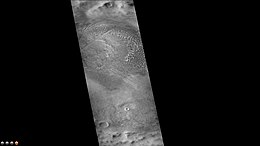
Hussey (crater)
Hussey Crater is an impact crater in the Phaethontis quadrangle on Mars at 53.8° S and 126.7° W. and is 99.0 km in diameter. Its name was approved in 1973, and it was named after William Hussey (astronomer) . [1]
Page Revisions
| Year | Metadata | Sections | Top Words | First Paragraph |
| 2018 |
77185 characters 3 sections 8 paragraphs 6 images 659 internal links 2 external links |
hussey 0.765 dunes 0.229 crater 0.153 brashear 0.153 dokuchaev 0.147 icaria 0.131 depicting 0.128 rifts 0.126 clark 0.126 enlargement 0.119 126 0.109 thaumasia 0.099 note 0.096 image 0.094 17th 0.092 |
Hussey Crater is an impact crater in the Phaethontis quadrangle on Mars at 53.8° S and 126.7° W. and is 99.0 km in diameter. Its name was approved in 1973, and it was named after William Hussey (astronomer) . [1] |
|
| 2017 |
35299 characters 2 sections 7 paragraphs 9 images 168 internal links 2 external links |
hussey 0.819 dunes 0.255 brashear 0.136 dokuchaev 0.131 crater 0.119 icaria 0.117 depicting 0.115 rifts 0.112 clark 0.112 enlargement 0.106 dots 0.101 126 0.097 ctx 0.093 thaumasia 0.088 note 0.086 |
Hussey Crater is an impact crater in the Phaethontis quadrangle on Mars at 53.8° S and 126.7° W. and is 99.0 km in diameter. Its name was approved in 1973, and it was named after William Hussey (astronomer) . [1] |
|
| 2015 |
31863 characters 2 sections 5 paragraphs 9 images 155 internal links 1 external links |
hussey 0.860 dunes 0.257 crater 0.129 dots 0.127 126 0.122 ctx 0.117 phaethontis 0.101 view 0.095 53 0.090 reconnaissance 0.090 99 0.089 hirise 0.087 enlarged 0.085 dune 0.085 camera 0.085 |
Hussey Crater is an impact crater in the Phaethontis quadrangle on Mars at 53.8° S and 126.7° W. and is 99.0 km in diameter. Its name was approved in 1973, and it was named after William Hussey (astronomer) . [1] Dunes are visible in the northern part of the crater floor. Pictures below show the dunes from a wide view and then eventually show greatly enlarged view with HiRISE. |